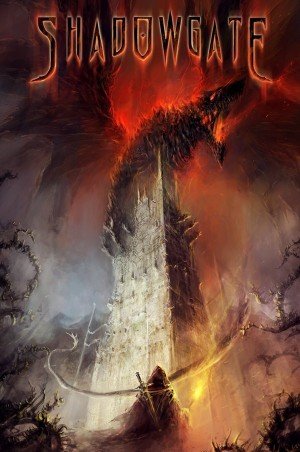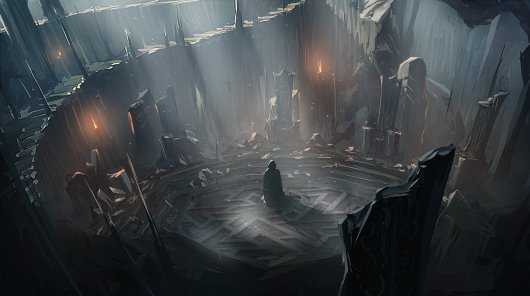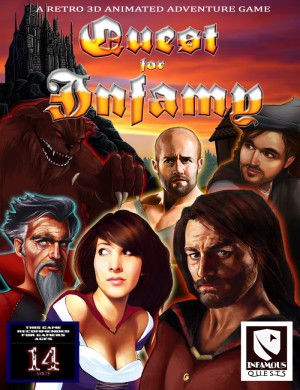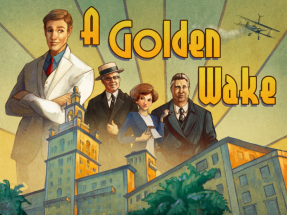Review for Shadowgate (2014)
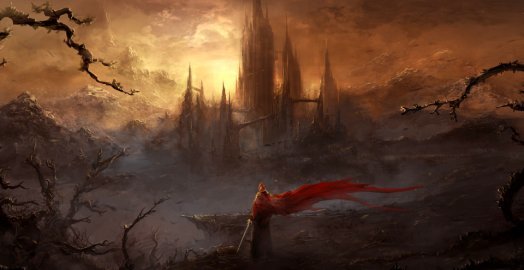
The castle of Shadowgate is a puzzle box, a sinister stronghold of secrets, challenges, and obstacles which ultimately provides the opportunity to become a hero of legend. The central character in Zojoi’s remake of the cult-classic Shadowgate, this living keep offers a treasure trove of puzzles and riddles which will confound, confuse, and likely dishearten even the most seasoned adventure gamer at times. It’s a game that is meant for a very particular audience – a patient and persistent one undaunted by the prospect of teeth-clenching frustration – but if you count yourself among those willing to venture into Shadowgate’s deadly spires, you’ll find a grand challenge waiting for you.
Like many games these days, the updated Shadowgate is a product of crowdfunding. So far, Kickstarter has been hit-or-miss for the adventure genre. For every success, we’ve also seen our fair share of disappointments, delayed games, and even controversies. This makes Shadowgate’s success all the more refreshing and inspirational – even more so considering its approach to gameplay remains uncompromisingly old-school. Of course, there is a reason that games like Shadowgate don’t exist anymore: it is definitely not designed for a mass market.
The game begins with you standing in front of a hidden entrance to the titular castle. Shadowgate is played in the first-person perspective, with players taking on the role of Jair Cathegar, an adventuring soldier briefly introduced in the opening cinematic. Jair has been called to the castle of Shadowgate by the enigmatic wizard Lakmir – although the reason he has been called only becomes apparent as you unravel the mystery of the keep.
The opening cinematic also introduces Shadowgate’s revamped art style. The original game was released in 1987 for the nascent Macintosh platform, and was played through windows featuring minimalist black and white illustrations of the castle’s rooms. An NES version followed in 1989, but still featured graphics restricted by the 8-bit system. In this 2014 remake, the game opens with spoken expository dialogue from Lakmir set against an abstract, impressionist-style series of landscape paintings depicting Jair’s approach to the keep. This visual style, both atmospheric and suggestive, continues to be used throughout the game, providing an immersive aesthetic for the dark medieval atmosphere. The castle of Shadowgate is a forbidding place, and the visual world that Zojoi has created deftly creates the impression that there is something to fear around each corridor.
Once you set foot inside the castle, the game’s plot begins slowly revealing itself, and it’s mostly standard fantasy material. An evil warlock is attempting to gain control of arcane powers hidden deep within, and it is up to Jair to stop his scheme. A “living castle,” Shadowgate has been trapped, tricked, and populated with a number of monsters that you will have to overcome to eventually face the evil warlock, Talimar.
While the set-up and traditional environment feel derivative now, what Shadowgate gets right is verisimilitude. It might be a fantasy world based on established tropes, but the game does an excellent job of making it seem like the castle and all its inhabitants – antagonists and protagonists, evil warlocks and slain wizards – are all important players in a very real place. From dialogue to room descriptions to the forgotten scrolls and journals found throughout the keep, the game is committed to creating a living, breathing world. During his adventure, Jair is forced to learn more about the castle’s past, its place in this world’s history, and even what part he will be forced to play.
Although each room in the castle is a fixed 2D image which can’t be viewed from different angles or perspectives, Zojoi has populated them with a number of effects and animations that help bring them to life. At the entrance to the keep, a heavy rain is falling. Inside Shadowgate’s doors, fog rolls down the circular stairs of one of its spires, and an escaped banshee howls as it comes flying towards you.
The sound in Shadowgate is also used very well. The orchestral soundtrack provides a perfect complement to the sinister mood of your journey through the castle, and there’s a number of musical cues, such as the staccato suspense theme that plays when a torch is about to run out, which augment the haunting atmosphere. As a tribute to its origins, Shadowgate also allows you to play the game with the original Nintendo soundtrack, which I did for novelty's sake, but quickly switched back because the tinny synthesized beeps were too incongruous. (You can choose to have the game’s scene transitions animate in the NES style as well.)
During a few cutscenes, the game features spoken dialogue from the Gandalfian Lakmir and the evil Talimar. Both are performed splendidly, hitting the perfect notes for a game in a dark fantasy world. Jair is almost completely silent – the only time he speaks is at the conclusion of a battle or during a strenuous activity. This is sadly played a little more for comedic relief, but it’s too infrequent to negatively affect the game. While there are some very rare moments of levity, most of the game is a foray into darkness, and the sound, graphics, and lethal challenges all reflect this.
The interface is simple and intuitive. At the top of the screen are a number of buttons which represent all of the actions you can take: look, take, open, close, go, eat, speak, hit, and use. Next to these buttons is a depiction of Jair himself, which changes depending on what gear he’s currently wearing. On the lower left of the screen, a knapsack is displayed, which allows you to access your inventory. Next to that is a map that tracks your progress through the keep.
A status window in the lower center of the screen provides textual information – often used for atmospheric details such as a cold wind blowing through Jair’s hair or information on how he is feeling. Early on you are able to pick up a skull, which provides the last interface element. This particular skull is different than the multitude of others strewn throughout Shadowgate’s corpse-littered halls, because it can talk, refers to itself as Yorick (har har) and becomes a permanent icon on the screen that can be “hit” in order to provide hints for overcoming the castle’s puzzles.
And riddles there be aplenty in this accurs’d place. The interface needs to be intuitive and simple, because the puzzles you will face while exploring are anything but. Overcoming each puzzle allows you to continue advancing deeper into the castle and learning more about what has happened to Shadowgate, its previous keepers, and how to defeat Talimar. There are three difficulty levels, Apprentice, Journeyman, and Master, which you can choose from before beginning the adventure, but all three are a challenge. Playing the game on Master level is the closest to the difficulty level of the original game, and should be reserved only for the most passionate of puzzle enthusiasts – or biggest masochists. The lower levels simplify some of the more complex puzzles or remove them entirely, but that still leaves more than enough challenge to go around.
I attempted my initial playthrough at the Journeyman level, and I’m not ashamed to admit that I needed to consult a walkthrough more than once. Or twice. Even if puzzles are what you live for, this won’t be a game you’ll be able to get through in one sitting. Playing Shadowgate reminded me of playing the classic text adventure Zork in many ways. Both feature a crawl through a nefarious dungeon, and both offer puzzles where the solutions are not going to be apparent the first time through, often requiring stepping away from the game to consider new approaches for each problem.
Puzzles come in a number of forms. In addition to the ubiquitous inventory obstacles, you will also need to overcome mechanical challenges and face a number of fantastic monsters. The castle is stocked full of items, both magical and mundane, and Jair can pocket almost all of them. This adds to the difficulty because only a handful are actually useful. In addition, you can learn new spells by reading from arcane scrolls, which provide Jair with new avenues of interaction with the castle. Some of Shadowgate’s puzzles are fairly simple – finding a shield to protect Jair from fiery dragon breath, for instance – but some are much more sophisticated, such as discovering how to use a trapped elemental spirit’s power, after first figuring out how to trap it.
While the puzzles start out easy (finding a key for a door), they quickly become extremely obtuse. Because many of them are so unintuitive, you may quickly find yourself trying to use every inventory item in your bag on every item or monster, and with so many items and spells to try, this process can become tedious. And while it’s great that Yorick provides an in-game hint system, many of his suggestions aren’t particularly helpful, providing the idea of a solution without the context for how to complete it.
My biggest criticism of the game is that too many of the game’s puzzle solutions, even after giving them considerable thought, simply don’t make sense or are hopelessly unintuitive. There are spells that work in some locations but not others (Jair’s opening spell is particularly finicky), castle mechanisms are found in some truly bizarre locations, and combat against the keep’s denizens is an exercise in trial and error. It exacts a price on the impression that the castle is a real, living place when so many of its challenges feel arbitrary.
Even worse, I sometimes had the right idea to solve a puzzle but used the incorrect button or didn’t choose the correct location in the scene to use an item or spell on. There’s a particular encounter with a riddling Djinn where I knew the answer, but had to consult a walkthrough to understand how to communicate it – and I still don’t understand the reasoning behind how I eventually did it.
I am not the hardcore puzzle-enthusiast that the game is most intended for, so I personally found such obstacles laborious. I wanted to know more about the castle’s past and story, but kept running into these narrative roadblocks that felt compulsory only for the sake of adding extra game time. However, given the ability to adjust the level of difficulty, as well as the fact that the remake’s intentions were to recapture the hardcore spirit of the original, I can’t entirely fault Shadowgate for being faithful to its roots. I respect this game more than I actually like it, but the dedication Zojoi has shown in faithfully recreating the gameplay in all its sadistic glory is admirable.
In addition to traps and monsters, you also have two more challenges to overcome. The first is that you have a finite number of torches, and while there are plenty to be found throughout the dungeon, if your journey takes too long or you do too much backtracking, you will eventually be consigned to lethal darkness. In addition, in one of the game’s first rooms Jair becomes cursed and can only take a certain number of actions before he needs to find a cure. Naturally, the cure is buried deep within the castle and even if you know exactly where it is, it is still a challenge to make it on time – in my final, successful playthrough, I only had a few actions remaining before it would have been game over again. Despite adding even more difficulty to an already-difficult game, however, these two time limits add a sense of impending doom that absolutely belong in the dark world of Shadowgate.
The penalty, by the way, for failing a puzzle, choosing the wrong approach to an encounter with a denizen of the keep, running out of torches, or not locating the cure for your curse in time is death. You will become acquainted with Shadowgate’s death scene early on and it will be a frequent companion throughout your journey. Obviously, saving often is essential.
Despite being a fairly linear game, the Shadowgate remake does offer some replay value which the original did not. There are a number of achievements you can strive for, such as finding the cure in a certain number of turns or overcoming a few obstacles in alternate ways, as well as an additional side quest to find the fabled “Black Axe,” which was cut from the original game but has been restored here.
This remake does precisely what it set out to do, and exactly what Zojoi promised when they ran their successful Kickstarter campaign two years ago. It is both a successful re-imagining and reinvention of the original – in fact, through the deft use of contemporary graphics, sound, and voice acting, they’ve created a game more immersive and captivating than the original. Of course, the reason that the original is a “cult” classic is because of its excruciating challenge, and even though the demands are slightly mitigated by difficulty levels this time around, the new Shadowgate is still old-school through and through, for better and for worse.
Gamers who aren’t interested in an adventure that interrupts its narrative frequently and sometimes arbitrarily, or adventurers who don’t have the time or inclination to struggle through Shadowgate’s brutal challenge level probably won’t find a lot of enjoyment within the keep’s haunted halls. This game requires a commitment. In fact, if you forgo relying on any outside assistance, it could easily take up to a month to solve the keep’s many confounding mysteries. However, if you’re up to the challenge; if the dark, foreboding corridors of a forgotten castle on the edge of a fantastic world don’t frighten you; if traps, tricks, and fiendish monsters in the dark don’t make you turn away in fear; and the prospect of mind-numbing, diabolic puzzles doesn’t deter you, then Shadowgate will offer you a journey into darkness, and an adventure unlike anything you have experienced in a long time.
WHERE CAN I DOWNLOAD Shadowgate (2014)
Shadowgate (2014) is available at:
We get a small commission from any game you buy through these links (except Steam).Our Verdict:
Zojoi’s Shadowgate remake is everything you loved – and maybe everything you hated – about old-school adventuring. It offers a captivating journey into a fantasy dungeon, but it’s inhabited by puzzles so artificially challenging that this quest is one not everyone will want to undertake.


